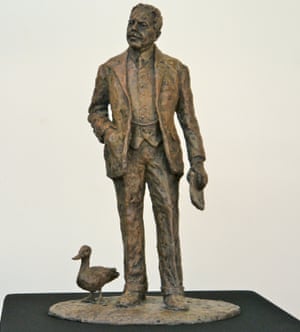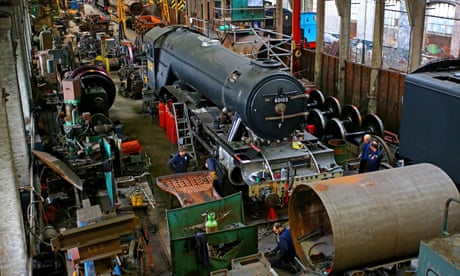Many of railway engineer Nigel Gresley’s trains were named after birds, so putting a mallard at his feet in his new statue seemed like a neat little visual pun. But not everyone agreed – and thus the duckers and the anti-duckers went to war
 Witty and charming, or a piece of ‘demeaning childishness’? … sculptor Hazel Reeves’s maquette for a new statue of Sir Nigel Gresley, including the problematic mallard
Witty and charming, or a piece of ‘demeaning childishness’? … sculptor Hazel Reeves’s maquette for a new statue of Sir Nigel Gresley, including the problematic mallard
Saturday 16 January 2016
Astatue of Sir Nigel Gresley, the designer of the world’s fastest steam locomotive, will be unveiled at King’s Cross station in London on 5 April, the 75th anniversary of Gresley’s death. It seems odd to write after such a harmless sentence that “argument rages”, and yet rage the argument certainly does, causing the kind of division where friends become enemies and the committees of learned societies break apart.
Controversial public sculpture is nothing new in Britain. Both the subject and the form of a piece can anger people: a short walk down the Strand provides examples of both – Sir Arthur “Bomber” Harris as a contentious subject and Jacob Epstein’s mutilated nudes (on the old British Medical Association building) as a once-shocking form. Gresley’s statue should present neither of these difficulties. The phrase “as every schoolboy knows” is no longer safe, but Sir Nigel comes close to George Stephenson and IK Brunel as the most generally admired of British railway engineers, and his bronze, to judge from the sculptor’s maquette, will be absolutely in the figurative tradition. Not far from where he worked as the London and North Eastern Railway’s chief mechanical engineer, Gresley will stand near the booking office looking affable, his left hand placed inside in his jacket pocket, possibly feeling for a pipe, while in his other hand, he holds a copy of a technical magazine.
All fine and good, but as things stand, something will be missing: a duck. On 3 July 1938, a Gresley engine hauling a seven-coach test train broke the speed record for steam locomotives on the downward slope of Stoke Bank, south of Grantham on the East Coast Main Line, where for a moment it reached 126mph. The engine was the Mallard, one of several streamlined Gresley express locomotives to be named after birds. (Others included Bittern, Golden Plover and Gannet; from the age of seven to 17, I saw Kingfisher regularly pass the bottom of our street.) The original version of the statue had a mallard waddling nicely at Gresley’s feet, a visual pun to remind us of the engineer’s famous achievement. Instead, it became the centre of possibly the most acrimonious argument in the long, pedantic history of the railway hobbyist.

FacebookTwitterPinterest Gresley (left) on the platform at King’s Cross Station in July 1930. Photograph: SSP/Getty
The story begins with money. In 2012, the Gresley Society was left £500,000 in a member’s will, a large sum for a small society of about 500 members dedicated to the preservation of the engineer’s memory and the quiet celebration of his work. Various suggestions were canvassed as to how the money might be spent, among them an idea vigorously promoted by Andrew Dow, the society’s vice chairman and a former director of the National Railway Museum, for some form of memorial. A bust became a statue. The sculptor Hazel Reeves was commissioned at a cost of £95,000 and a public appeal started that eventually raised £13,000; the legacy meant the society could be relaxed about the shortfall. Reeves’ maquette showing man and duck met the approval of English Heritage, Network Rail, which owned the site, and Camden Council, the planning authority, as well as the Gresley Society council.
Advertisement
That was in November 2014. Early the next year, Dow had a letter from Tim Godfrey, one of the society’s vice-presidents, saying he didn’t much care for the duck. Godfrey and his brother Ben are Gresley’s grandchildren. A special meeting of the council was summoned in Peterborough where, according to Dennis Butler, who was then the society’s publicity officer, it was explained that “we would have to keep the duck off the memorial if we wanted to keep good relations with the Gresley family”. At a further meeting in March 2015 – this time attended by the Godfrey brothers – Dow, Butler and another council member, Nigel Dant, resigned after failing to persuade their colleagues that the duck should stay. The chairman, David McIntosh, referred in a letter to “significant adverse feedback from many old friends”.
Dow, who was by now seriously ill, died the following month, though not beforethe pro-duck party began an online petition, which to date has attracted 2,700 signatures, including railway historians, artists, Michael Portillo and Sir William McAlpine, who, as the man who saved an earlier Gresley locomotive, the Flying Scotsman, from sale to an American consortium 40 years ago, has done more to save the engineer’s heritage in Britain than anyone else. The broad church of the pro-duckers sees charm and wit in the mallard, as well as what art historians know as an “attribute” – an object added to the main figure that may help to explain his or her significance. But the anti-duckers of the Gresley Society are implacable. To them, the duck is a piece of childishness that demeans a great man. “We felt it detracted from the dignity of the statue,” McIntosh said last week. His council had originally “gone along with it”, but only with silent misgivings.

Full steam ahead as Flying Scotsman set to return to mainline by end of 2015
Why the society so respects the wishes of Gresley’s grandchildren is a puzzle that their critics seem unable to solve. Nothing suggests that the society has had funds from them; there have been arguments about which side – society or family – should pay for the restoration and upkeep of the Gresley grave at Netherseal in Derbyshire. But the family does seem proud. From his home in Shropshire last week, Tim Godfrey said that he never discussed “that subject [the duck] on the telephone” and yet in the same short conversation inserted the information that the Gresleys arrived with William the Conqueror. As indeed they did: by the 12th century, the engineer’s ancestors had built a motte-and-bailey castle at Gresley near Burton-on-Trent; in the early 17th century a hereditary baronetcy was created in that name. So, for a railway engineer, Gresley was rather grand. According to his biographer, Geoffrey Hughes, he spent his honeymoon in Burnley, which few people not from there have done, but later in life could afford the lease of an Elizabethan manor house, Salisbury Hall near St Albans, where Charles II is reported to have stayed with Nell Gwynn.
Advertisement
The manor had a moat and the moat had ducks. A photograph showing Sir Nigel feeding these ducks has been seized by the pro-duckers as evidence of an ornithological bent that prompted him to name his streamliners after birds. But his grandson insisted this was nonsense. The LNER had a naming committee and his grandfather was no more or less interested in ducks than anyone else who tossed bread at them, he told me. Oddly – though that’s too mild a word – Tim Godfrey is himself a duck breeder, listed by the British Waterfowl Association as a good source for teals, mandarins and Carolinas. No mallards, though: ‘“You can find them anywhere.”
Sometimes during my short investigation of this story, I thought of how it might suit a dark Ealing comedy such as Kind Hearts and Coronets: Gresley was from the cadet branch of the family, which meant that after he was knighted in 1936 there were two Sir Nigel Gresleys, the other being the baronet. At other times I thought of Marcel Varnel’s Oh, Mr Porter!: the first scene, in which men in top hats and ladies in fine dresses have gathered to name one of Gresley’s streamliners and Will Hay’s clumsiness nearly drowns them all in a flood of misdirected engine-water.
But mainly what I thought was how sad and stupid it would be – how hopelessly dim-witted – for Gresley to go without his duck.



.jpg)
.jpg)



0 comments:
Post a Comment